BN-PVDF/rGO-PVDF Laminate Nanocomposites for Energy Storage Applications
Abstract
1. Introduction
2. Materials and Methods
2.1. Synthesis of rGO and BNNS
2.2. Fabrication of rGO/BNNS-PVDF Microlaminate Composites
2.3. Characterization
3. Results and Discussion
3.1. Exfoliation of BNNS
3.2. Structure and Dielectric Properties of Microlaminate Composites
3.3. Thermal Properties of the Composites
4. Conclusions
Supplementary Materials
Author Contributions
Funding
Data Availability Statement
Acknowledgments
Conflicts of Interest
References
- Guo, F.; Shen, X.; Zhou, J.; Liu, D.; Zheng, Q.; Yang, J.; Jia, B.; Lau, A.K.; Kim, J.K. Highly thermally conductive dielectric nanocomposites with synergistic alignments of graphene and boron nitride nanosheets. Adv. Funct. Mater. 2020, 30, 201910826. [Google Scholar] [CrossRef]
- Zhang, C.; Shi, Z.; Mao, F.; Yang, C.; Yang, J.; Zhu, X.; Zuo, H. Polymer composites with balanced dielectric constant and loss via constructing trilayer architecture. J. Mater. Sci. 2018, 53, 13230–13242. [Google Scholar] [CrossRef]
- Korolkov, I.V.; Zhumanazar, N.; Gorin, Y.G.; Yeszhanov, A.B.; Zdorovets, M.V. Enhancement of electrochemical detection of Pb2+ by sensor based on track-etched membranes modified with interpolyelectrolyte complexes. J. Mater. Sci. Mater. Electron. 2020, 31, 20368–20377. [Google Scholar] [CrossRef]
- Yakovenko, O.; Lazarenko, O.; Matzui, L.; Vovchenko, L.; Borovoy, M.; Tesel’ko, P.; Lozitsky, O.; Astapovich, K.; Trukhanov, A.; Trukhanov, S. Effect of Ga content on magnetic properties of BaFe12− xGaxO19/epoxy composites. J. Mater. Sci. 2020, 55, 9385–9395. [Google Scholar] [CrossRef]
- Zdorovets, M.V.; Kozlovskiy, A.L.; Shlimas, D.I.; Borgekov, D.B. Phase transformations in FeCo–Fe2CoO4/Co3O4-spinel nanostructures as a result of thermal annealing and their practical application. J. Mater. Sci. Mater. Electron. 2021, 32, 16694–16705. [Google Scholar] [CrossRef]
- Zhang, D.; Liu, W.; Guo, R.; Zhou, K.; Luo, H. High discharge energy density at low electric field using an aligned titanium dioxide/lead zirconate titanate nanowire array. Adv. Sci. 2018, 5, 1700512. [Google Scholar] [CrossRef]
- Vinnik, D.A.; Zhivulin, V.E.; Sherstyuk, D.P.; Starikov, A.Y.; Zezyulina, P.A.; Gudkova, S.A.; Zherebtsov, D.A.; Rozanov, K.N.; Trukhanov, S.V.; Astapovich, K.A.; et al. Electromagnetic properties of zinc–nickel ferrites in the frequency range of 0.05–10 GHz. Mater. Today Chem. 2021, 20, 100460. [Google Scholar] [CrossRef]
- Feng, Y.; Wu, Q.; Deng, Q.; Peng, C.; Hu, J.; Xu, Z. High dielectric and breakdown properties obtained in a PVDF based nanocomposite with sandwich structure at high temperature via all-2D design. J. Mater. Chem. C 2019, 7, 6744–6751. [Google Scholar] [CrossRef]
- Donnay, M.; Tzavalas, S.; Logakis, E. Boron nitride filled epoxy with improved thermal conductivity and dielectric breakdown strength. Compos. Sci. Technol. 2015, 110, 152–158. [Google Scholar] [CrossRef]
- Wu, Y.; Wang, Z.; Shen, X.; Liu, X.; Han, N.M.; Zheng, Q.; Mai, Y.W.; Kim, J.K. Graphene/boron nitride–polyurethane microlaminates for exceptional dielectric properties and high energy densities. ACS Appl. Mater. Interf. 2018, 10, 26641–26652. [Google Scholar] [CrossRef]
- Sima, W.; Jiang, X.; Peng, Q.; Sun, P. Investigation of dielectric properties of polyethylene terephthalate under different aging temperatures. IEEE Trans. Dielec. Electr. Insul. 2017, 24, 3015–3023. [Google Scholar] [CrossRef]
- Xie, L.; Huang, X.; Huang, Y.; Yang, K.; Jiang, P. Core@ double-shell structured BaTiO3–polymer nanocomposites with high dielectric constant and low dielectric loss for energy storage application. J. Phys. Chem. C 2013, 117, 22525–22537. [Google Scholar] [CrossRef]
- Hu, P.; Shen, Y.; Guan, Y.; Zhang, X.; Lin, Y.; Zhang, Q.; Nan, C.W. Topological-structure modulated polymer nanocomposites exhibiting highly enhanced dielectric strength and energy density. Adv. Funct. Mater. 2014, 24, 3172–3178. [Google Scholar] [CrossRef]
- Thakur, V.K.; Gupta, R.K. Recent progress on ferroelectric polymer-based nanocomposites for high energy density capacitors: Synthesis, dielectric properties, and future aspects. Chem. Rev. 2016, 116, 4260–4317. [Google Scholar]
- Selvaraj, M.; Senthilkumar, R.; Balaji, R.; Selvasekarapandian, S.; Manivasagam, T.G. Influence of graphene oxide and reduced graphene oxide on dielectric properties of PZT/PVDF composite films. AIP Conf. Proc. 2019, 2162, 020056. [Google Scholar]
- Guo, R.; Luo, H.; Yan, M.; Zhou, X.; Zhou, K.; Zhang, D. Significantly enhanced breakdown strength and energy density in sandwich-structured nanocomposites with low-level BaTiO3 nanowires. Nano Energy 2021, 79, 105412. [Google Scholar] [CrossRef]
- Kozlovskiy, A.L.; Shlimas, D.I.; Zdorovets, M.V. Synthesis, structural properties and shielding efficiency of glasses based on TeO2-(1-x) ZnO-xSm2O3. J. Mater. Sci. Mater. Electron. 2021, 32, 12111–12120. [Google Scholar] [CrossRef]
- Almessiere, M.A.; Güner, S.; Slimani, Y.; Hassan, M.; Baykal, A.; Gondal, M.A.; Baig, U.; Trukhanov, S.V.; Trukhanov, A.V. Structural and magnetic properties of Co0. 5Ni0. 5Ga0. 01Gd0. 01Fe1. 98O4/ZnFe2O4 spinel ferrite nanocomposites: Comparative study between sol-gel and pulsed laser ablation in liquid approaches. Nanomaterials 2021, 11, 2461. [Google Scholar] [CrossRef]
- Yousefi, N.; Sun, X.; Lin, X.; Shen, X.; Jia, J.; Zhang, B.; Tang, B.; Chan, M.; Kim, J.K. Highly aligned graphene/polymer nanocomposites with excellent dielectric properties for high-performance electromagnetic interference shielding. Adv. Mater. 2014, 26, 5480–5487. [Google Scholar] [CrossRef]
- Li, Q.; Zhang, G.; Liu, F.; Han, K.; Gadinski, M.R.; Xiong, C.; Wang, Q. Solution-processed ferroelectric terpolymer nanocomposites with high breakdown strength and energy density utilizing boron nitride nanosheets. Energy Environ. Sci. 2015, 8, 922–931. [Google Scholar] [CrossRef]
- Dang, Z.M.; Zheng, M.S.; Zha, J.W. 1D/2D carbon nanomaterial-polymer dielectric composites with high permittivity for power energy storage applications. Small 2016, 12, 1688–1701. [Google Scholar] [CrossRef] [PubMed]
- Zhu, Y.; Zhu, Y.; Huang, X.; Chen, J.; Li, Q.; He, J.; Jiang, P. High energy density polymer dielectrics interlayered by assembled boron nitride nanosheets. Adv. Energy Mater. 2019, 9, 1901826. [Google Scholar] [CrossRef]
- Padilha, J.E.; Pontes, R.B.; Fazzio, A. Bilayer graphene on h-BN substrate: Investigating the breakdown voltage and tuning the bandgap by electric field. J. Phys. Cond. Matter 2012, 24, 075301. [Google Scholar] [CrossRef] [PubMed]
- Wang, Z.; Tang, Z.; Xue, Q.; Huang, Y.; Huang, Y.; Zhu, M.; Pei, Z.; Li, H.; Jiang, H.; Fu, C.; et al. Fabrication of boron nitride nanosheets by exfoliation. Chem. Record 2016, 16, 1204–1215. [Google Scholar] [CrossRef] [PubMed]
- Jo, I.; Pettes, M.T.; Kim, J.; Watanabe, K.; Taniguchi, T.; Yao, Z.; Shi, L. Thermal conductivity and phonon transport in suspended few-layer hexagonal boron nitride. Nano Lett. 2013, 13, 550–554. [Google Scholar] [CrossRef] [PubMed]
- Li, Q.; Chen, L.; Gadinski, M.R.; Zhang, S.; Zhang, G.; Li, H.U.; Iagodkine, E.; Haque, A.; Chen, L.Q.; Jackson, T.N.; et al. Flexible high-temperature dielectric materials from polymer nanocomposites. Nature 2015, 523, 576–579. [Google Scholar] [CrossRef]
- Wang, M.; Jiao, Z.; Chen, Y.; Hou, X.; Fu, L.; Wu, Y.; Li, S.; Jiang, N.; Yu, J. Enhanced thermal conductivity of poly (vinylidene fluoride)/boron nitride nanosheet composites at low filler content. Compos. Part A Appl. Sci. Manuf. 2018, 109, 321–329. [Google Scholar] [CrossRef]
- Shahil, K.M.; Balandin, A.A. Graphene–multilayer graphene nanocomposites as highly efficient thermal interface materials. Nano Lett. 2012, 12, 861–867. [Google Scholar] [CrossRef]
- Li, J.; Kim, J.K. Percolation threshold of conducting polymer composites containing 3D randomly distributed graphite nanoplatelets. Compos. Sci. Technol. 2007, 67, 2114–2120. [Google Scholar] [CrossRef]
- Shen, X.; Zheng, Q.; Kim, J.K. Rational design of two-dimensional nanofillers for polymer nanocomposites toward multifunctional applications. Prog. Mater. Sci. 2021, 115, 100708. [Google Scholar] [CrossRef]
- Yu, S.; Shen, X.; Kim, J.K. Beyond homogeneous dispersion: Oriented conductive fillers for high κ nanocomposites. Mater. Horiz. 2021, 8, 3009–3042. [Google Scholar] [CrossRef] [PubMed]
- Lin, X.; Shen, X.; Zheng, Q.; Yousefi, N.; Ye, L.; Mai, Y.W.; Kim, J.K. Fabrication of highly-aligned, conductive, and strong graphene papers using ultralarge graphene oxide sheets. ACS Nano 2012, 6, 10708–10719. [Google Scholar] [CrossRef] [PubMed]
- Lei, W.; Mochalin, V.N.; Liu, D.; Qin, S.; Gogotsi, Y.; Chen, Y. Boron nitride colloidal solutions, ultralight aerogels and freestanding membranes through one-step exfoliation and functionalization. Nat. Commun. 2015, 6, 8849. [Google Scholar] [CrossRef] [PubMed]
- Santagiuliana, G.; Picot, O.T.; Crespo, M.; Porwal, H.; Zhang, H.; Li, Y.; Rubini, L.; Colonna, S.; Fina, A.; Barbieri, E.; et al. Breaking the nanoparticle loading–dispersion dichotomy in polymer nanocomposites with the art of croissant-making. ACS Nano 2018, 12, 9040–9050. [Google Scholar] [CrossRef]
- Zhu, W.; Gao, X.; Li, Q.; Li, H.; Chao, Y.; Li, M.; Mahurin, S.M.; Li, H.; Zhu, H.; Dai, S. Controlled gas exfoliation of boron nitride into few-layered nanosheets. Angew. Chem. 2016, 128, 10924–10928. [Google Scholar] [CrossRef]
- Ding, J.H.; Zhao, H.R.; Yu, H.B. High-yield synthesis of extremely high concentrated and few-layered boron nitride nanosheet dispersions. 2D Mater. 2018, 5, 045015. [Google Scholar] [CrossRef]
- Sainsbury, T.; O’Neill, A.; Passarelli, M.K.; Seraffon, M.; Gohil, D.; Gnaniah, S.; Spencer, S.J.; Rae, A.; Coleman, J.N. Dibromocarbene functionalization of boron nitride nanosheets: Toward band gap manipulation and nanocomposite applications. Chem. Mater. 2014, 26, 7039–7050. [Google Scholar] [CrossRef]
- Tian, X.; Li, Y.; Chen, Z.; Li, Q.; Hou, L.; Wu, J.; Tang, Y.; Li, Y. Shear-assisted production of few-layer boron nitride nanosheets by supercritical CO2 exfoliation and its use for thermally conductive epoxy composites. Sci. Rep. 2017, 7, 17794. [Google Scholar] [CrossRef]
- Li, W.; Song, Z.; Zhong, J.; Qian, J.; Tan, Z.; Wu, X.; Chu, H.; Nie, W.; Ran, X. Multilayer-structured transparent MXene/PVDF film with excellent dielectric and energy storage performance. J. Mater. Chem. C 2019, 7, 10371–10378. [Google Scholar] [CrossRef]
- Feng, Y.; Li, M.L.; Li, W.L.; Zhang, T.D.; Zhao, Y.; Fei, W.D. Polymer/metal multi-layers structured composites: A route to high dielectric constant and suppressed dielectric loss. Appl. Phys. Lett. 2018, 112, 022901. [Google Scholar] [CrossRef]
- American Society for Testing and Materials. Standard Test Method for Dielectric Breakdown Voltage and Dielectric Strength of Solid Electrical Insulating Materials at Commercial Power Frequencies; ASTM: West Conshohocken, PA, USA, 2013. [Google Scholar]
- Danikas, M.G.; Tanaka, T. Nanocomposites-a review of electrical treeing and breakdown. IEEE Electr. Insul. Mag. 2009, 25, 19–25. [Google Scholar] [CrossRef]
- Wu, W.; Liu, X.; Qiang, Z.; Yang, J.; Liu, Y.; Huai, K.; Zhang, B.; Jin, S.; Xia, Y.; Fu, K.K.; et al. Inserting insulating barriers into conductive particle channels: A new paradigm for fabricating polymer composites with high dielectric permittivity and low dielectric loss. Compos. Sci. Technol. 2021, 216, 109070. [Google Scholar] [CrossRef]
- Wu, W.; Zhao, W.; Sun, Q.; Yu, B.; Yin, X.; Cao, X.; Feng, Y.; Li, R.K.; Qu, J. Surface treatment of two dimensional MXene for poly (vinylidene fluoride) nanocomposites with tunable dielectric permittivity. Compos. Comm. 2021, 23, 100562. [Google Scholar] [CrossRef]
- Wang, L.; Luo, H.; Zhou, X.; Yuan, X.; Zhou, K.; Zhang, D. Sandwich-structured all-organic composites with high breakdown strength and high dielectric constant for film capacitor. Compos. Part A Appl. Sci. Manuf. 2019, 117, 369–376. [Google Scholar] [CrossRef]
- Yu, S.; Zhang, J.; Zhu, X.; Yin, Y.; Xue, J.; Xia, F.; Li, Y.; Xue, Q. Plate-barrier architecture of rGO-TiO2 derived from MXene for constructing well-aligned polymer nanocomposites with excellent dielectric performance. Compos. Sci. Technol. 2022, 218, 109191. [Google Scholar] [CrossRef]
- Wang, B.; Yin, X.; Peng, D.; Zhang, Y.; Wu, W.; Gu, X.; Na, B.; Lv, R.; Liu, H. Highly thermally conductive PVDF-based ternary dielectric composites via engineering hybrid filler networks. Compos. Part B Eng. 2020, 191, 107978. [Google Scholar] [CrossRef]
- Gu, J.; Lv, Z.; Wu, Y.; Guo, Y.; Tian, L.; Qiu, H.; Li, W.; Zhang, Q. Dielectric thermally conductive boron nitride/polyimide composites with outstanding thermal stabilities via in-situ polymerization-electrospinning-hot press method. Compos. Part A Appl. Sci. Manuf. 2017, 94, 209–216. [Google Scholar] [CrossRef]
- Wu, K.; Lei, C.; Yang, W.; Chai, S.; Chen, F.; Fu, Q. Surface modification of boron nitride by reduced graphene oxide for preparation of dielectric material with enhanced dielectric constant and well-suppressed dielectric loss. Compos. Sci. Technol. 2016, 134, 191–200. [Google Scholar] [CrossRef]
- Lin, B.; Li, Z.T.; Yang, Y.; Li, Y.; Lin, J.C.; Zheng, X.M.; He, F.A.; Lam, K.H. Enhanced dielectric permittivity in surface-modified graphene/PVDF composites prepared by an electrospinning-hot pressing method. Compos. Sci. Technol. 2019, 172, 58–65. [Google Scholar] [CrossRef]
- Yang, C.; Hao, S.J.; Dai, S.L.; Zhang, X.Y. Nanocomposites of poly (vinylidene fluoride)-Controllable hydroxylated/carboxylated graphene with enhanced dielectric performance for large energy density capacitor. Carbon 2017, 117, 301–312. [Google Scholar] [CrossRef]
- Li, C.Q.; Zha, J.W.; Long, H.Q.; Wang, S.J.; Zhang, D.L.; Dang, Z.M. Mechanical and dielectric properties of graphene incorporated polypropylene nanocomposites using polypropylene-graft-maleic anhydride as a compatibilizer. Compos. Sci. Technol. 2017, 153, 111–118. [Google Scholar] [CrossRef]
- Hu, D.; Jiang, M.; Hou, Y.; Zhang, J.; Fang, D.; Liu, L.; Huang, J.; Li, H.; Xiong, C. Dielectric loss suppression of silver/poly (vinylidene fluoride) composite films with polydopamine. J. Macromol. Sci. Part B Phys. 2018, 57, 255–265. [Google Scholar] [CrossRef]
- Hu, B.; Guo, H.; Wang, Q.; Zhang, W.; Song, S.; Li, X.; Li, Y.; Li, B. Enhanced thermal conductivity by constructing 3D-networks in poly (vinylidene fluoride) composites via positively charged hexagonal boron nitride and silica coated carbon nanotubes. Compos. Part A Appl. Sci. Manuf. 2020, 137, 106038. [Google Scholar] [CrossRef]
- Wu, C.; Huang, X.; Wu, X.; Xie, L.; Yang, K.; Jiang, P. Graphene oxide-encapsulated carbon nanotube hybrids for high dielectric performance nanocomposites with enhanced energy storage density. Nanoscale 2013, 5, 3847–3855. [Google Scholar] [CrossRef]
- Fang, X.; Liu, X.; Cui, Z.K.; Qian, J.; Pan, J.; Li, X.; Zhuang, Q. Preparation and properties of thermostable well-functionalized graphene oxide/polyimide composite films with high dielectric constant, low dielectric loss and high strength via in situ polymerization. J. Mater. Chem. A 2015, 3, 10005–10012. [Google Scholar] [CrossRef]
- Luo, B.; Wang, X.; Wang, Y.; Li, L. Fabrication, characterization, properties and theoretical analysis of ceramic/PVDF composite flexible films with high dielectric constant and low dielectric loss. J. Mater. Chem. A 2014, 2, 510–519. [Google Scholar] [CrossRef]
- Li, P.; Shen, H.; Qian, Z.; Yang, X.; Zhao, N.; Zhu, C.; Xu, J. Facile fabrication of flexible layered GO/BNNS composite films with high thermal conductivity. J. Mater. Sci. 2018, 53, 4189–4198. [Google Scholar] [CrossRef]
- Chen, J.; Huang, X.; Sun, B.; Jiang, P. Highly thermally conductive yet electrically insulating polymer/boron nitride nanosheets nanocomposite films for improved thermal management capability. ACS Nano 2019, 13, 337–345. [Google Scholar] [CrossRef]
- Chen, J.; Wei, H.; Bao, H.; Jiang, P.; Huang, X. Millefeuille-inspired thermally conductive polymer nanocomposites with overlapping BN nanosheets for thermal management applications. ACS Appl. Mater. Interf. 2019, 11, 31402–31410. [Google Scholar] [CrossRef]
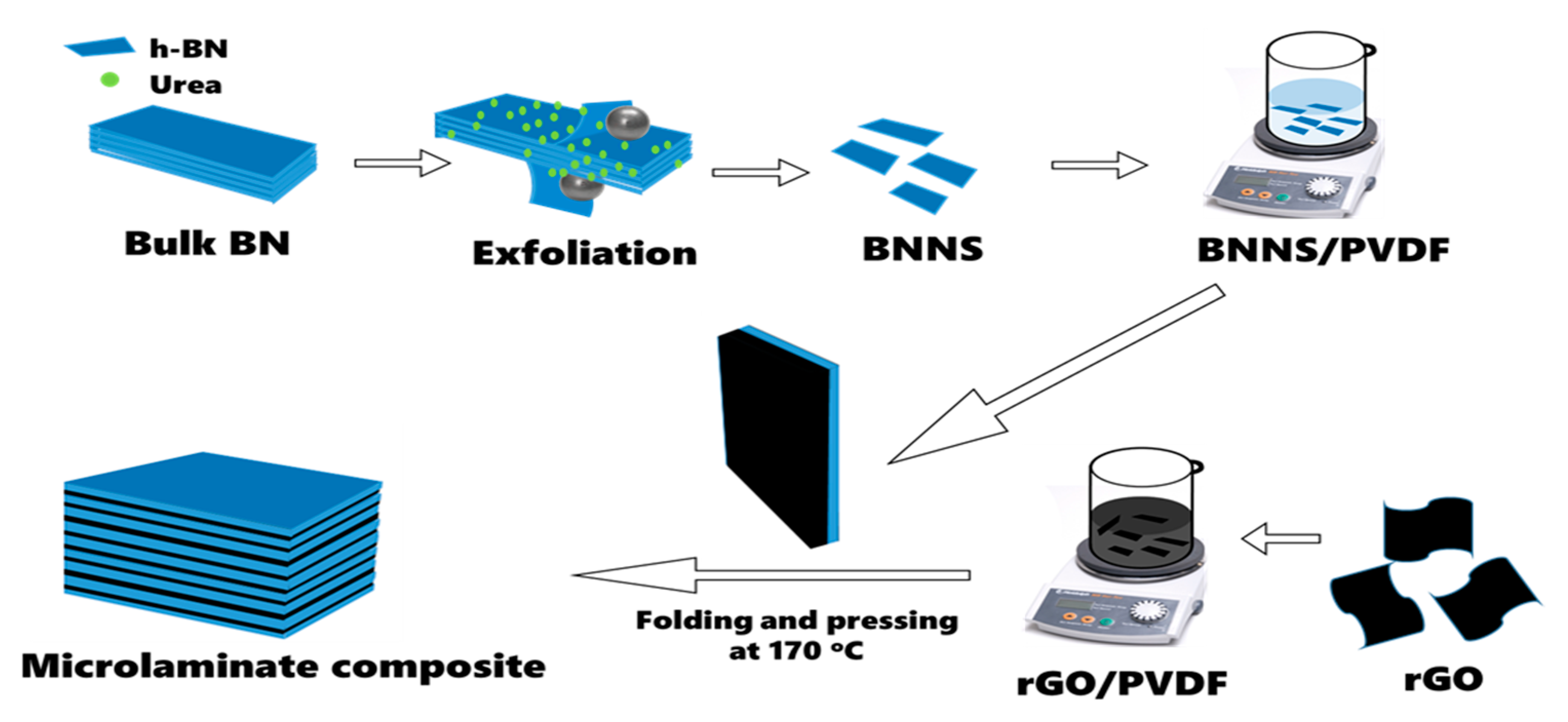
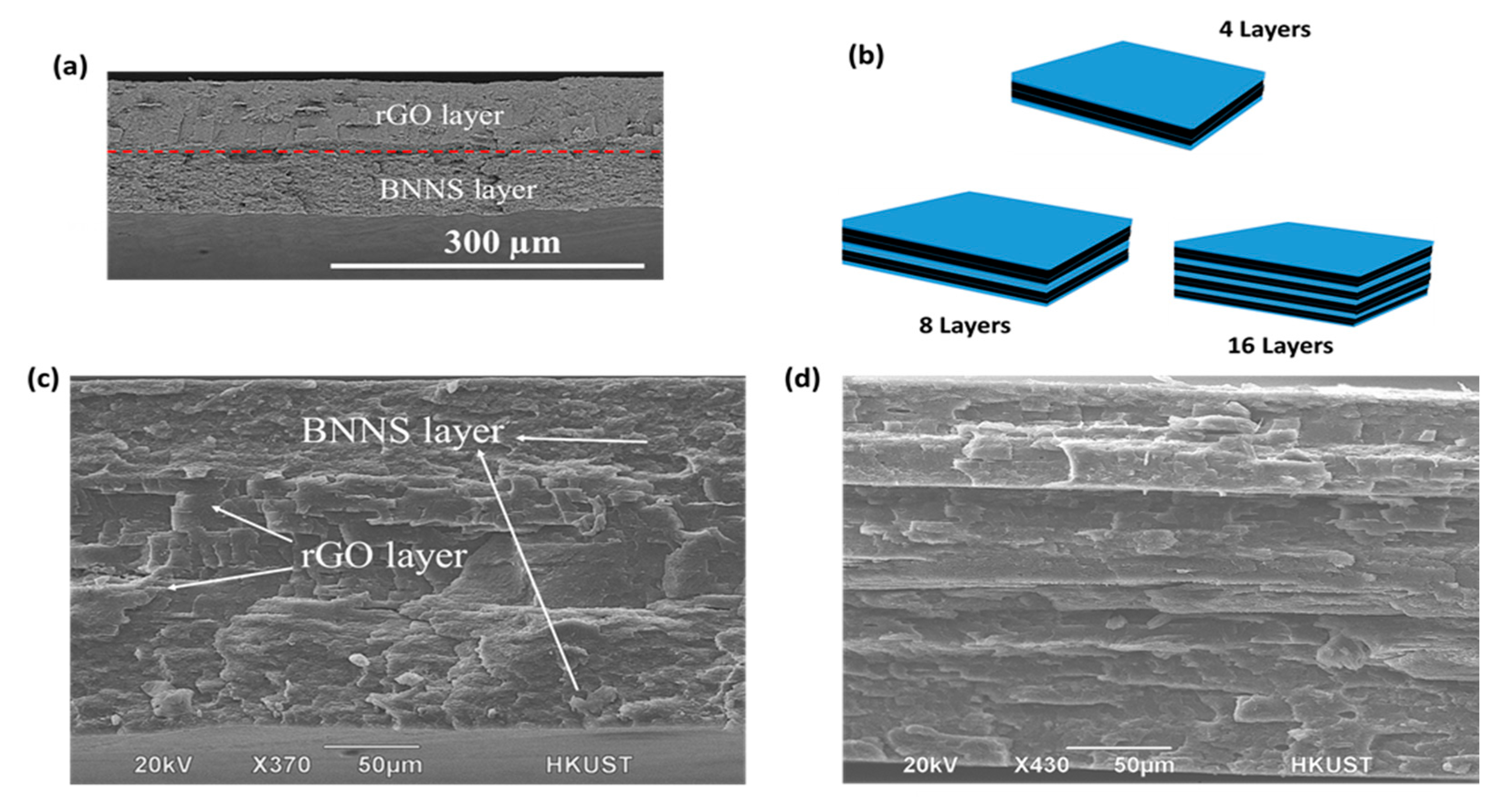
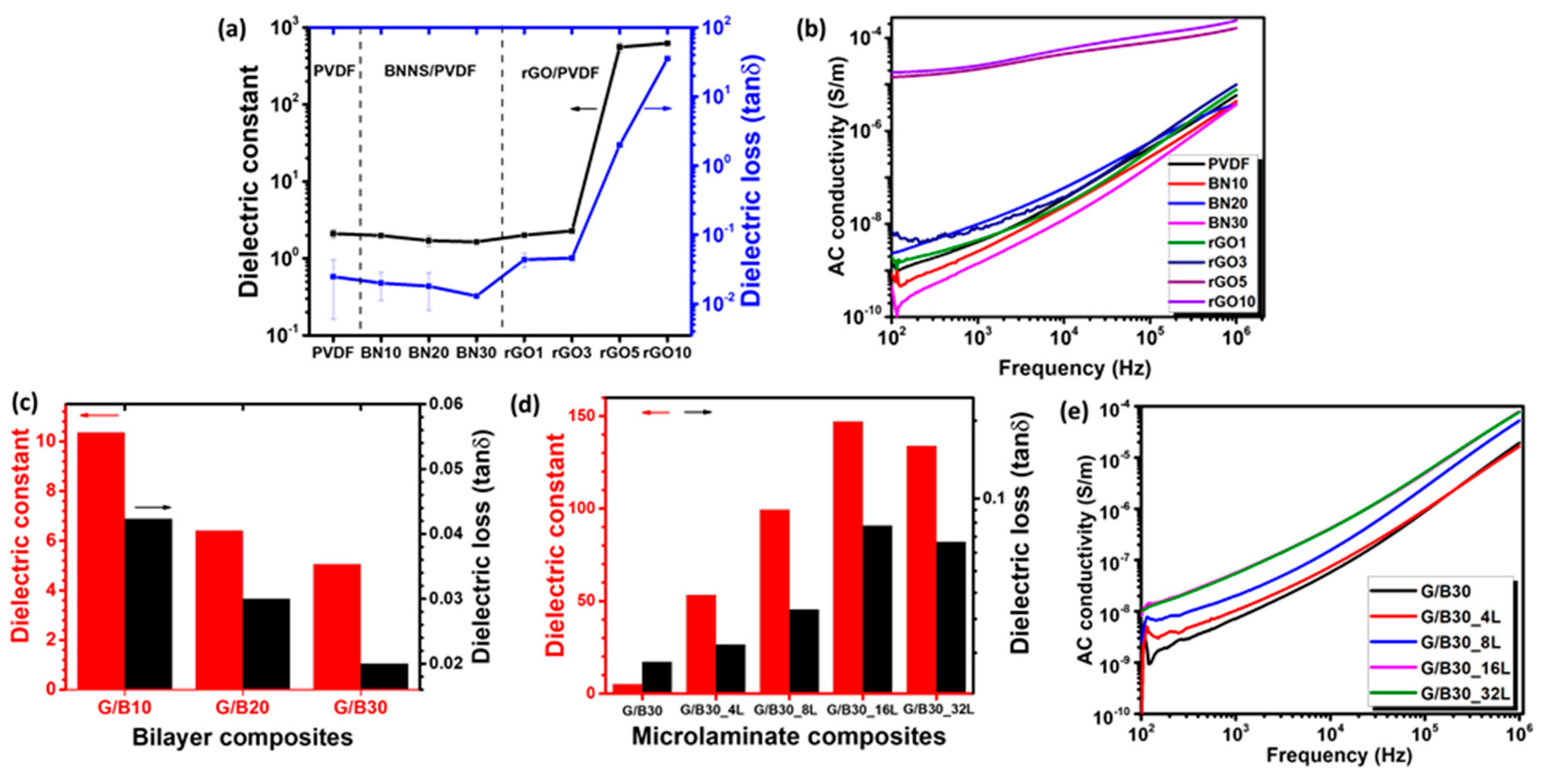
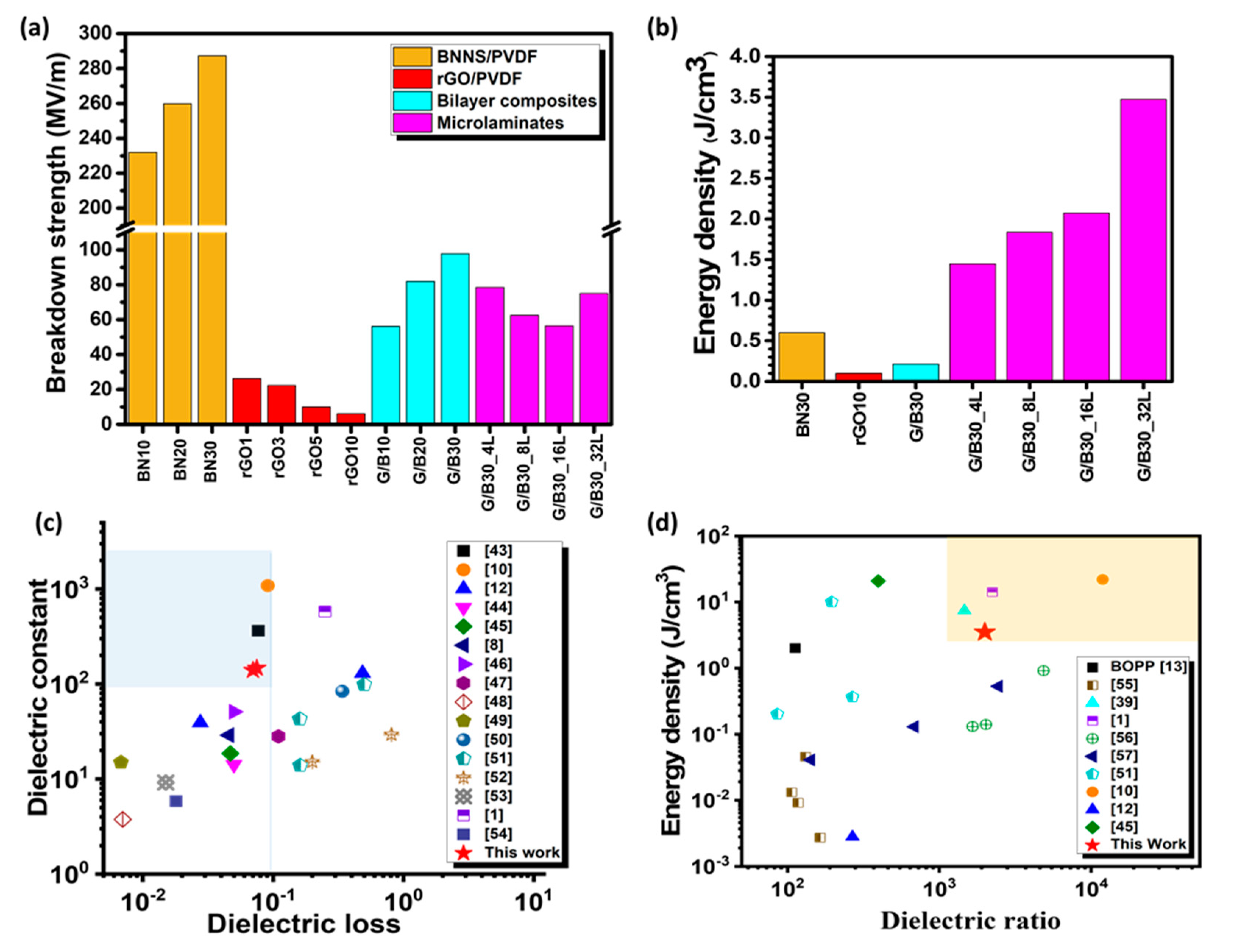
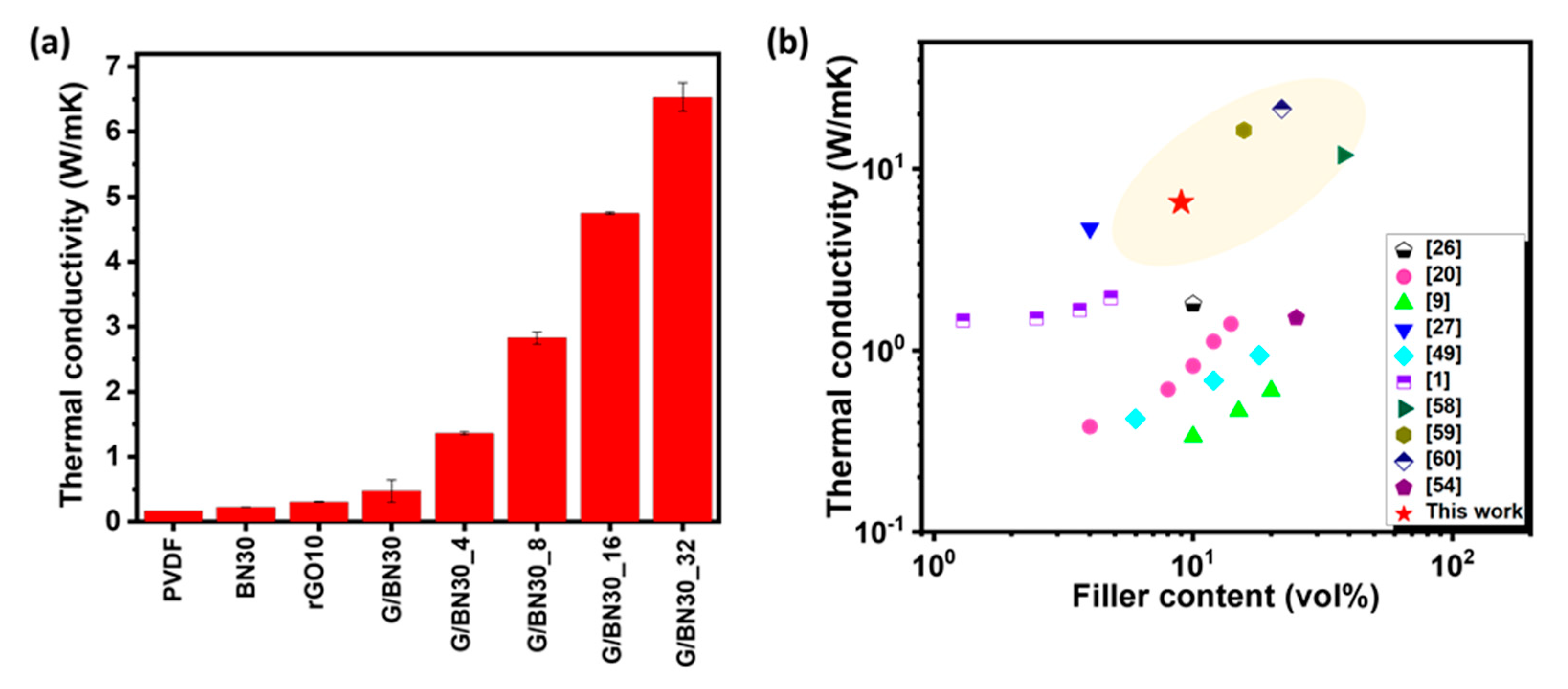
| Materials | At 1 kHz | Ref. | |
|---|---|---|---|
| Dielectric Constant | Dielectric Loss (tan ) | ||
| BaTiO3/Graphite/PDMS | 73.5 | 0.19 | [43] |
| rGO-PU/BN-PU | 1084 | 0.091 | [10] |
| BT@HBP/PMMA-4 | 130 | 0.485 | [12] |
| BT@HBP@PMMA-4 | 39.3 | 0.0276 | |
| PVDF/Mxene@CTAB | 82.1 | 0.2 | [44] |
| PVDF/P(VDF-TrFE-CTFE)/PVDF | 18.61 | 0.047 | [45] |
| Mxene/PVDF | 29 | 0.046 | [8] |
| rGO-TiO2/PVDF | 211 | 0.104 | [46] |
| PVDF/hBN/SiC | 28.1 | 0.11 | [47] |
| mBN/PI | 3.77 | 0.007 | [48] |
| epoxy/h-BN/rGO | 15 | 0.0068 | [49] |
| SMG/PVDF | 83.8 | 0.34 | [50] |
| GROH/PVDF | 98.91 | 0.501 | [51] |
| 42.9 | 0.16 | ||
| 13.91 | 0.161 | ||
| FGS/PP | 29.4 | 0.81 | [52] |
| 15.2 | 0.2 | ||
| Ag-PDOP/PVDF | 9.2 | 0.015 | [53] |
| rGO-PI/BNNS-PI | 579 | 0.25 | [1] |
| BN/CNT/PVDF | 5.86 | 0.018 | [54] |
| G/B30_16L | 147.1 | 0.075 | This work |
| G/B30_32L | 139.5 | 0.07 | |
| Materials | Dielectric Ratio | Energy Density (J/cm3) | Ref. |
|---|---|---|---|
| GO/CNT/PU | 164 | 0.0027 | [55] |
| 117 | 0.0092 | ||
| 107 | 0.013 | ||
| 131 | 0.046 | ||
| PPD-CFGO/PI | 1656 | 0.13 | [56] |
| 2030 | 0.14 | ||
| 4857 | 0.91 | ||
| Dopamine@BCZT/PVDF | 143 | 0.041 | [57] |
| 684 | 0.13 | ||
| 2446 | 0.53 | ||
| GROH/PVDF | 86 | 0.20 | [51] |
| 268 | 0.37 | ||
| 196 | 10.07 | ||
| rGO-PU/BN-PU | 11912 | 22.70 | [10] |
| Mxene/PVDF | 1464 | 7.40 | [39] |
| BT@HBP/PMMA-4 | 268 | 0.0028 | [12] |
| PVDF/P(VDF-TrFE-CTFE)/PVDF | 396 | 20.86 | [45] |
| rGO-PI/BNNS-PI | 2316 | 14.20 | [1] |
| G/B30_32L | 1993 | 3.50 | This work |
| Materials | Filler Content (Vol%) | Thermal Conductivity (Wm−1K−1) | Ref. |
|---|---|---|---|
| c-BCB/BNNS | 10 | 1.80 | [26] |
| GO/BNNS/PVA | 38.01 | 11.90 | [58] |
| BNNS/P(VDF-TrFE-CFE) | 14 | 1.40 | [20] |
| 8 | 0.61 | ||
| BNNS/epoxy | 20 | 0.60 | [9] |
| 10 | 0.34 | ||
| BNNS/PVDF | 15.71 | 16.30 | [59] |
| BNNS/PVA | 22 | 21.40 | [60] |
| BNNS/PVDF | 4 | 4.69 | [27] |
| BNNS/rGO/epoxy | 18 | 0.94 | [49] |
| rGO-PI/BNNS-PI | 1.30 | 1.49 | [1] |
| 4.82 | 1.95 | ||
| m-h-BN/MWCNTs-SiO2/PVDF | 25 | 1.51 | [54] |
| G/B30_32L | 10 | 6.53 | This work |
Publisher’s Note: MDPI stays neutral with regard to jurisdictional claims in published maps and institutional affiliations. |
© 2022 by the authors. Licensee MDPI, Basel, Switzerland. This article is an open access article distributed under the terms and conditions of the Creative Commons Attribution (CC BY) license (https://creativecommons.org/licenses/by/4.0/).
Share and Cite
Agbabiaka, O.G.; Adegun, M.H.; Chan, K.-Y.; Zhang, H.; Shen, X.; Kim, J.-K. BN-PVDF/rGO-PVDF Laminate Nanocomposites for Energy Storage Applications. Nanomaterials 2022, 12, 4492. https://doi.org/10.3390/nano12244492
Agbabiaka OG, Adegun MH, Chan K-Y, Zhang H, Shen X, Kim J-K. BN-PVDF/rGO-PVDF Laminate Nanocomposites for Energy Storage Applications. Nanomaterials. 2022; 12(24):4492. https://doi.org/10.3390/nano12244492
Chicago/Turabian StyleAgbabiaka, Okikiola Ganiu, Miracle Hope Adegun, Kit-Ying Chan, Heng Zhang, Xi Shen, and Jang-Kyo Kim. 2022. "BN-PVDF/rGO-PVDF Laminate Nanocomposites for Energy Storage Applications" Nanomaterials 12, no. 24: 4492. https://doi.org/10.3390/nano12244492
APA StyleAgbabiaka, O. G., Adegun, M. H., Chan, K.-Y., Zhang, H., Shen, X., & Kim, J.-K. (2022). BN-PVDF/rGO-PVDF Laminate Nanocomposites for Energy Storage Applications. Nanomaterials, 12(24), 4492. https://doi.org/10.3390/nano12244492







